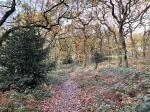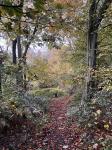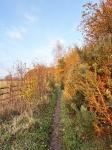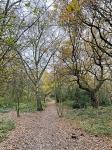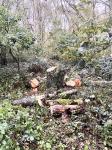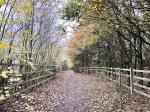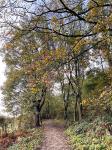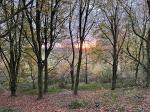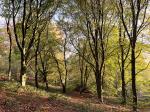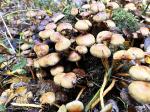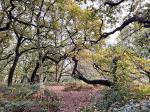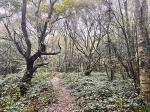Brayton Barff Through the Seasons.
Set in the Vale of York, South West of the market town of Selby and between the villages of Thorpe Willoughby and Brayton, lies Brayton Barff, a sandstone Hill approximately one hundred and fifty feet in height which was formed by glacial movement during the last Ice Age. It is a significant landmark in an otherwise flat landscape.
Today the site is primarily owned by Yorkshire Water with Selby District Council owning a small patch of the land adjacent to the A63 Selby bypass. A large underground reservoir occupies the centre of the site which delivers water to around 4.7 million customers throughout Yorkshire.
Within the Barff woodland over 40% of the trees are Sessile Oak which are generally found in semi natural woodlands in the north of the country. These trees are so called because its acorns are not held on stalks, like those of the English Oak (Pedunculate), but attached directly to the outer twigs. There are also several English Oak trees as well as some cross-hybrid oaks. These trees are known to support many species of flora and fauna, invertebrates, mosses, lichen and fungi.
During the Victorian times it is thought that the shipbuilders on the east coast would come over to the Barff for selected cuts of timber to build their sea going vessels.
The Barff also has a variety of other trees including Silver Birch, Beech, Sycamore, Holly, Rowan, Scots Pine, Alder, Hawthorne and European Larch. There are also several Yew, Willow, Hazel, Horse Chestnut and Wych Elm. As with similar woodlands there are a variety of bushes, including Honeysuckle, Elderberry, Gorse, Broom and Buddleia.
The history of Brayton Barff is quite vague, apparently during 1803 a beacon was lit on the Barff when the country was threatened with an invasion by Napoleon. In May 1935, to celebrate King George V's Silver Jubilee, a Bonfire was lit on the Barff as part of the celebrations.
Early issues of Ordnance Survey Maps dated 1903 clearly show a rifle range on the Barff, extending out to Mill Lane. During the 
Between 2001 – 2004 the A63 Selby bypass, 10km twin lane single carriageway was constructed which severed the South West corner of the Barff, adjacent to Selby Golf Course and resulted in a slight redesign of several holes on the golf course. Wooden fencing was erected as a result of this new road running alongside of the Barff and a footbridge constructed over the ‘new road’ following the line of the Bridal way which extends from Mill Lane. Around 2005/2006 a definite 2metre wide limestone aggregate footpath was laid forming a circular path around the outer edges of the woodland. This footpath is approximately 1.2 miles in length and takes about 30 minutes to circumnavigate at a leisurely pace.
In 2012 the Barff was declared an Ancient Oak Woodland and as such throughout 2012 and 2013 significant work had been carried out by the relevant agencies to cut and remove large swathes of non-native trees, creating at that time huge scars on the landscape. Some three years later the planting of the native trees have become well established and are flourishing. Ongoing maintenance work on the footpath around the bottom of the Barff was completed during the Summer of 2016.
A second phase of woodland maintenance commenced during the Autumn of 2019 with the removal of many old and diseased trees and the cutting back of the Gorse and Broom bushes, especially adjacent to the ‘bypass trail’, this work continued through till March 2020 with re planting continuing into April 2020.
Brayton Barff is a popular site for walkers and bird watchers alike and a path circling the outer perimeter of the Barff makes a pleasant thirty minute walk, giving views looking over towards Selby and the village of Brayton as well as the power stations of Drax and Eggborough..jpg)
For the early risers it is a great place to see some stunning sunrises over the villages of Brayton looking towards Drax Power Station, the same with the Sunsets looking over towards Eggborough and Monk Fryston.
The Barff changes with the Seasons and every visit can reveal something new, the woodland is a haven for wildlife. Records show that since 1982 one hundred and twelve species of bird have been seen in the woodland and at least 40 of those have bred here, including Tawny Owl, Buzzard, Green Woodpecker, Spotted Flycatcher, Goldcrest and Nuthatch to name just a few. On average over 70 species of bird are recorded each year. Further details of the bird life on the Barff can be found on the Brayton Barff Group Facebook page, especially the posts from Derek Cooper. Today ‘The Friends of Brayton Barff group’ led by Derek and a small team of volunteers help keep and maintain the cleanliness of the site as well as recording the wildlife and bird sightings.
The Barff is also home to fifteen different species of mammals, including Muntjac Deer, Pipistrelle Bat, Fox, and Field Vole.
Over eighty species of plant and wildflowers have been recorded, included Bee Orchid, Northern Marsh Orchid, Wood Anemone, Marsh Ragwort, Bluebell, White Bluebell, Bittersweet and Purple and White Foxgloves. Over twenty species of Butterfly have been recorded, including Marbled White, Brown Angus, Speckled Wood, Comma and Brimstone.
During the Autumnal months fungi thrives in this woodland environment, species including Fly Agaric, Beefsteak Tree Fungi, Chicken of the Wood, Sulphur Tufts, Stinkhorn, Ink cap, Puffballs and Hoof Bracket are just some of the many varieties that can be found here.
Click on the galleries shown below to expand the albums.
November 2023
Thursday the second of November and Storm Ciaran has finally arrived on the shores of the UK, fortunately it only really affected the south of the country and Ireland and did not cause any problems here in our part of North Yorkshire.
It has been a wet weekend making the ground waterlogged, and more rain is forecast over the coming few days.
The smell of fireworks, gunpowder and smoke filled the air on my walk to the Barff this morning (Monday 6th November) The woodland floor is heavily sodden. It was quite a bright start earlier with a lovely sunrise just after 7.00am, I was hopeful that I was going to see some sunshine today but, unfortunately, no sooner had the sun rose above the power station than the low cloud moved in and within the hour it was pouring with rain, which made for a long-wet walk home.
Wednesday 8th November was a dull and damp day, the overnight rain continued throughout the day with a cool freshening easterly wind which, as a result covered the Barff in a golden blanket of fallen leaves. Despite the rain and drizzle the autumnal colours were beautiful this morning. Everywhere was extremely wet and it was becoming very muddy underfoot. A pair of Jays were very vocal this morning near to the grassy camp area adjacent to the Bypass trail, their strong screechy call quite unmistakable, certainly against the steady drone of traffic speeding along the bypass.
Saturday 11th we had a lovely walk on the Barff this morning, with a nice albeit short sunrise at 7.30am. There had been an overnight frost, sufficient to ice over the car windscreen. It was good to hear a pair of Buzzards calling to each other above the Maze fields, Blackbird, Robin, and Wren were all very vocal this morning. Not to be left out but the Grey Squirrels were making a fair bit of noise too, chattering to each other as they played chase running up and around the tree trunks of some of the old oak trees.
An Orange weather warning was issued at 10.00am on Monday 13th as Storm Debi hits our part of North Yorkshire, the strong westerly winds blowing the leaves off the trees like confetti and forming a huge golden-brown blanket on the woodland floor. It was much milder this morning with the temperature gauge reading 9C at 8.00am. The wind increasing as the day wore on and by mid-afternoon, we were getting gusting winds of between 50mph – 60mph with squally rain showers. The surrounding fields have been waterlogged for several weeks now with standing water forming huge pools, we really do need some heavy frosts to give the ground the opportunity to dry out a little.
Tuesday 14th November, what a contrast to yesterday, this morning was a very mild, 8c, and flat calm, the winds of the previous day now causing problems in Europe, the only noise I could hear was the constant noise of the traffic on the Selby Bypass. That said the Blackbirds, Wrens and Robins were all quite vocal, celebrating the easing of yesterday’s storm force winds. Other than a few light twigs and lots of leaves the Barff has coped very well with yesterday’s storm.
Friday 17th was a dull, dark miserable morning, weather wise, it was still very wet and slippery underfoot, Robim and Wren were having a sing off between themselves. By midmorning, the sun had broken through the low cloud, so I decided to go back and have another walk around the Barff in the sunshine. The autumn colours of the Oak, Beach and Birch trees were beautiful in the mid-morning sunlight. There were lots of different varieties of Fungi growing through the leaf litter and on the rotting tree stumps, the warm damp atmosphere providing ideal growing conditions especially for Sulphur Tuft and Shaggy Parasol species.
Saturday 18th was yet another dull and dark morning, it was slightly cooler than yesterday at 6C, the overnight rain making the ground extremely slippery and muddy, the exposed tree roots are quite hazardous if you should stand on one. I heard a flock of Goldcrest this morning as I walked along the Bypass trail, their tiny, delicate song quite unmistakable compared to the much coarser Wren and Robin.
Wednesday 22nd was another dark, dull, and damp morning, we had a very wet drizzly walk, with a light westerly breeze, it was very muddy and slippery underfoot. The Autumn colours are still beautiful, the persistent breeze continues to blow the surviving leaves onto the floor, forming a fresh covering on the ground. The sheep which have been grazing in one of the paddocks adjacent to Sherwood's farm for most of the year look to have moved to pastures new, I have not seen them for several days now.
A pair of Jays were quite active and very vocal again this morning, these colourful members of the Crow family have quite a passion for acorns. It has been recoded that a single Jay will bury as many as 5,000 of them every autumn, often carrying them for miles from the parent tree. The hidden food cashes will form part of the bird’s food source throughout the chilly winter months. They have an incredible memory as well as being highly intelligent and will remember were many of its acorn cashes have been stored. That said, many are never retrieved and come next spring they will have germinated. It is estimated that jay’s plant nearly two billion acorns a year.
Saturday 25th November was a bitterly chilly morning, with an overnight frost, the cold northerly blustery wind making it feel much colder, the Barff is still quite muddy and slippery in places off the main perimeter footpath. Bird song was quite vocal this morning, Blackbird, Wren & Robin most vocal, closely followed by Goldcrest and Long Tailed Tits.
Sunday 26th November and another freezing chilly morning after an overnight frost, it was still dark at 7.00am, the temperature barely above freezing, there was a nice sunrise around 7.30am though that soon clouded over a brief time later.
The Barff is still rich in fungi, with clumps of Sulphur Tuft, Birch Polypore, and Shaggy Parasols. Earthballs seem to have been around for ages though I note that of late several of them have exploded.
The cold snap continued over the weekend and into the last week of November with overnight frosts and icy cold mornings.
Wednesday 29th was the coldest morning of the winter so far with an air temperature at 6.45am of -2c. It was a cold, fresh start to the day with an icy northerly wind. The sky was clear with a light blue hazy hue, by 7.30am we had a low, deep red sunrise which lingered for a good ten minutes or so, which silhouetted the skyline over by the power station. A fresh blanket of fallen leaves covered the woodland floor, making it quite crunchy and crisp to walk on. Blackbirds were chirping in the trees, others busily foraging for food amongst the leaves. Every now and then I could hear several Goldcrests singing high up amongst the upper reaches of the holly bushes, accompanied by the delicate calling of the Long-Tailed Tits. It was a beautiful morning for a walk, had I not got other commitments later in the day, I could have spent the whole morning on the Barff. Frosty mornings look to continue into the beginning of December.
|

